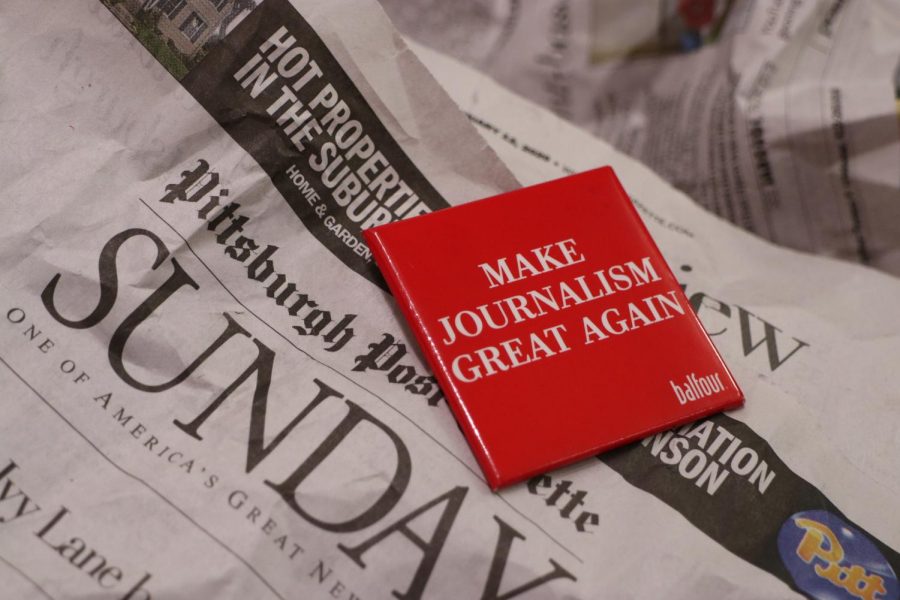No News is Not Good News
The Newseum closed this year, but does it signal more than poor business?
The recent closing of Washington D.C.’s Newseum may have been an economic inevitability, but it points to larger issues concerning the health of American journalism.
January 14, 2020
As clocks anxiously ticked toward midnight across the eastern seaboard of the United States, optimistically ushering in a new decade, Washington D.C.’s Newseum closed its doors for the final time. The museum, a beacon for the history and perpetuation of free speech, was sold–the Freedom Forum, the company that owns the museum, was forced to unload its valuable Pennsylvania Avenue property to prevent financial ruin. The Newseum simply declared, “We’re on deadline,” but the newly adopted slogan only scratches the surface of the real issue: an overall devaluation of free speech and true journalism.
It’s an issue that is all too often associated with President Donald Trump, who is routinely criticized for his treatment of the press. From popularizing the concept of “fake news” to suspending CNN correspondent Jim Acosta’s press pass, Trump’s toxic relationship with a majority of the mainstream media is unprecedented. He has set an example that freedom of the press, both in the United States and abroad, is something that can be coaxed, twisted, and manipulated.
I won’t suggest that there’s a direct causative relationship–the Newseum’s closing was an unfortunate side-effect of capitalism. I will, however, highlight one of the museum’s particularly thought-provoking exhibits. It was a story-tale map of the world, with each country labeled by the freedom of the press as “free,” “partly free,” and “not free.” With each country, there were other statistics–the number of journalists persecuted, the strictness of web censorship, etc. The United States was, unsurprisingly, fairly good in these areas. However, we were labeled as having “lingering issues.”
While the exhibit did not elaborate on the “lingering issues,” it is clear that certain of our troubles stem from the President’s perverse treatment of the media. So although the closing of the Newseum certainly isn’t Trump’s fault, it is a shame. It’s a shame because, if the President’s trend of maligning the media continues, America might just need a reminder of the fundamental importance of free speech. We might just need a reminder of how we got to the dangerous path that we’re currently on.
Our country will likely never become a veritable Iran, with the government entirely shutting off internet access. Nor is the future of the United States akin to that of China, with state-run media determining what to report as the “truth.” Nevertheless, the Newseum’s demise should be mourned because its mission was to combat untruthful media-scape–one concerned with party and self-interest, one that is currently (and perhaps henceforth) centered at 1600 Pennsylvania Avenue.
When I first visited the Newseum in middle school, I hadn’t yet started writing for The Uproar, and studying journalism in college hadn’t even crossed my mind. The visit wasn’t an experience that automatically inspired me–it wasn’t love at first sight. It was, however, transformative to my view of media. The Pulitzer Prize-winning photos, walls covered with 9/11 headlines, and articles dating back to the 1300s were all deeply impactful.

The Newseum on Pennsylvania Avenue in Washington DC closed on December 31, 2019. The valuable property was purchased by Johns Hopkins University.
So although I know what true journalism looks like–the sacrifices, humanity, truth, and, most importantly, news–many don’t. Not everyone notices the value of reporting, and not everyone had the opportunity to see the Newseum. Both Democratic and Republican culture is leaning toward a subscription to Trump’s attitude. It’s not limited to mainstream media, either. Even on a local level, even at The Uproar, objectively poor journalism can be spurred by threats of ending up like the Newseum. On deadline.
What’s more, this issue isn’t one to be solved without effort. It can’t be solved without an industry-wide shift in policy, a shift from what makes good money to what makes good journalism.














Eliza Ross • Jan 26, 2020 at 7:53 pm
Nice photo